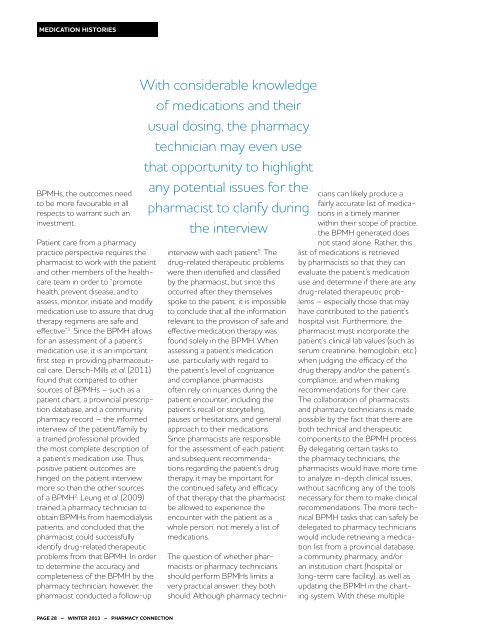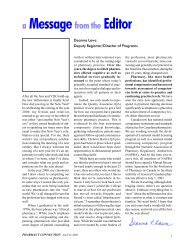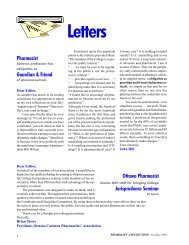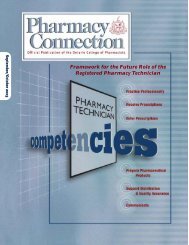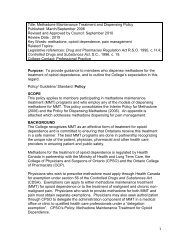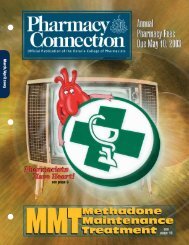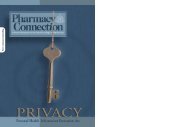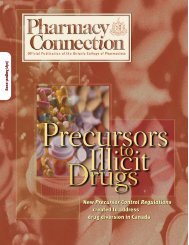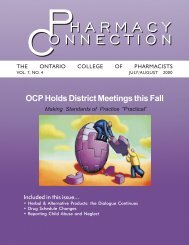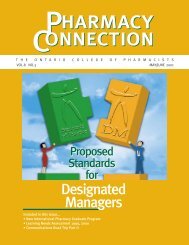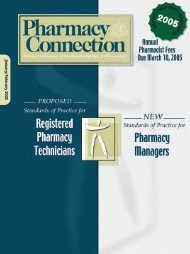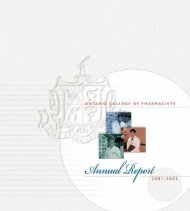Download - Ontario College of Pharmacists
Download - Ontario College of Pharmacists
Download - Ontario College of Pharmacists
You also want an ePaper? Increase the reach of your titles
YUMPU automatically turns print PDFs into web optimized ePapers that Google loves.
MEDICATION HISTORIES<br />
BPMHs, the outcomes need<br />
to be more favourable in all<br />
respects to warrant such an<br />
investment.<br />
Patient care from a pharmacy<br />
practice perspective requires the<br />
pharmacist to work with the patient<br />
and other members <strong>of</strong> the healthcare<br />
team in order to “promote<br />
health, prevent disease, and to<br />
assess, monitor, initiate and modify<br />
medication use to assure that drug<br />
therapy regimens are safe and<br />
effective” 1 . Since the BPMH allows<br />
for an assessment <strong>of</strong> a patient’s<br />
medication use, it is an important<br />
first step in providing pharmaceutical<br />
care. Dersch-Mills et al. (2011)<br />
found that compared to other<br />
sources <strong>of</strong> BPMHs – such as a<br />
patient chart, a provincial prescription<br />
database, and a community<br />
pharmacy record – the informed<br />
interview <strong>of</strong> the patient/family by<br />
a trained pr<strong>of</strong>essional provided<br />
the most complete description <strong>of</strong><br />
a patient’s medication use. Thus,<br />
positive patient outcomes are<br />
hinged on the patient interview<br />
more so than the other sources<br />
<strong>of</strong> a BPMH 2 . Leung et al. (2009)<br />
trained a pharmacy technician to<br />
obtain BPMHs from haemodialysis<br />
patients, and concluded that the<br />
pharmacist could successfully<br />
identify drug-related therapeutic<br />
problems from that BPMH. In order<br />
to determine the accuracy and<br />
completeness <strong>of</strong> the BPMH by the<br />
pharmacy technician, however, the<br />
pharmacist conducted a follow-up<br />
With considerable knowledge<br />
<strong>of</strong> medications and their<br />
usual dosing, the pharmacy<br />
technician may even use<br />
that opportunity to highlight<br />
any potential issues for the<br />
pharmacist to clarify during<br />
the interview<br />
interview with each patient 5 . The<br />
drug-related therapeutic problems<br />
were then identified and classified<br />
by the pharmacist, but since this<br />
occurred after they themselves<br />
spoke to the patient, it is impossible<br />
to conclude that all the information<br />
relevant to the provision <strong>of</strong> safe and<br />
effective medication therapy was<br />
found solely in the BPMH. When<br />
assessing a patient’s medication<br />
use, particularly with regard to<br />
the patient’s level <strong>of</strong> cognizance<br />
and compliance, pharmacists<br />
<strong>of</strong>ten rely on nuances during the<br />
patient encounter, including the<br />
patient’s recall or storytelling,<br />
pauses or hesitations, and general<br />
approach to their medications.<br />
Since pharmacists are responsible<br />
for the assessment <strong>of</strong> each patient<br />
and subsequent recommendations<br />
regarding the patient’s drug<br />
therapy, it may be important for<br />
the continued safety and efficacy<br />
<strong>of</strong> that therapy that the pharmacist<br />
be allowed to experience the<br />
encounter with the patient as a<br />
whole person, not merely a list <strong>of</strong><br />
medications.<br />
The question <strong>of</strong> whether pharmacists<br />
or pharmacy technicians<br />
should perform BPMHs limits a<br />
very practical answer: they both<br />
should. Although pharmacy technicians<br />
can likely produce a<br />
fairly accurate list <strong>of</strong> medications<br />
in a timely manner<br />
within their scope <strong>of</strong> practice,<br />
the BPMH generated does<br />
not stand alone. Rather, this<br />
list <strong>of</strong> medications is retrieved<br />
by pharmacists so that they can<br />
evaluate the patient’s medication<br />
use and determine if there are any<br />
drug-related therapeutic problems<br />
– especially those that may<br />
have contributed to the patient’s<br />
hospital visit. Furthermore, the<br />
pharmacist must incorporate the<br />
patient’s clinical lab values (such as<br />
serum creatinine, hemoglobin, etc.)<br />
when judging the efficacy <strong>of</strong> the<br />
drug therapy and/or the patient’s<br />
compliance, and when making<br />
recommendations for their care.<br />
The collaboration <strong>of</strong> pharmacists<br />
and pharmacy technicians is made<br />
possible by the fact that there are<br />
both technical and therapeutic<br />
components to the BPMH process.<br />
By delegating certain tasks to<br />
the pharmacy technicians, the<br />
pharmacists would have more time<br />
to analyze in-depth clinical issues,<br />
without sacrificing any <strong>of</strong> the tools<br />
necessary for them to make clinical<br />
recommendations. The more technical<br />
BPMH tasks that can safely be<br />
delegated to pharmacy technicians<br />
would include retrieving a medication<br />
list from a provincial database,<br />
a community pharmacy, and/or<br />
an institution chart (hospital or<br />
long-term care facility), as well as<br />
updating the BPMH in the charting<br />
system. With these multiple<br />
PAGE 28 ~ WINTER 2013 ~ PHARMACY CONNECTION


